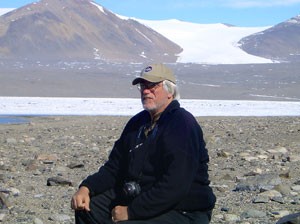Science and Technology
From Dec. 16 to Jan. 15, Peter Smith, principal investigator for the Phoenix Mars Mission, and six of his colleagues took a trip to Antarctica to explore a landscape resembling the one on the Red Planet.
The Mars Lander is slated to touch down May 25. Following a mission motto of “”follow the water,”” the Lander will dig down to icy layers, take samples and figure out if it is a place where life can exist.
Smith wrote a proposal to visit Antarctica in order to compare the polar regions of Mars to the ones on earth.
He secured funding from NASA and the National Science Foundation, and made the trip with Chris McKay and Aaron Zent from the Ames Research Center; Doug Ming from the Johnson Space Center; Susanne Douglas from NASA’s Jet Propulsion Lab; and Sam Kounaves from Tufts University.
“”Antarctica is a scene similar to Mars, only Mars is even colder and even dryer,”” Smith said. “”We went to the high valleys where there are no lakes or streams and recreated the same experiments that the Lander will be doing on Mars.””
The scientists dug deep down into the soil where there was ice, and took samples that are still being processed.
In late July or early August, they will be able to compare these results to the ones yielded from Mars.
“”I was very pleased to find that in the lower valleys you could see living microbes after putting dye in the soil,”” Smith said. “”There were 100 times more life forms at the soil ice boundary then in the ice above.””
What was important about the discovery, Smith said, was that they took samples in a place with no plants, no animals and no liquid water, yet were still able to chisel into sandstone and dig into the soil and find evidence of life, including algae, bacteria and nematodes.
As on Mars, you can tell there used to be water, he said.
“”Even in the most extreme, dry, desolate areas, life forms exist,”” Smith said. “”Whether they exist on Mars is a mystery.””
Smith and his colleagues spent 30 hours on a plane, two days in survival camp and a month living in tents or on the ground and melting ice for water in a place where even in the summer there is white in every direction. They had to battle 40 to 50 mph winds and extreme cold.
They took a helicopter 100 miles into the high valleys. Smith remembered seeing dead seals and penguins that had wandered there and could not escape.
“”Besides the dead animals that could not survive in those harsh conditions, the dominant creatures were nematodes, 1-millimeter worms among the living bacterial communities,”” he said.
In addition to the living microbes, they encountered fossils like sheets of paper.
“”Antarctica is unlike any place you are used to, but it is very beautiful,”” Smith said.
While the climate was harsh and the valleys remote, it is nothing to what they would experience on Mars.
“”That is why I’m a big fan of robotic missions,”” Smith said.
Even the Lander will be able to withstand only six months at most on the Red Planet, he said.
After the sun goes down, “”the Phoenix will freeze to death,”” Smith said.
“”If we are fortunate to find life on Mars, it could be the most amazing discovery of the 21st century.””









